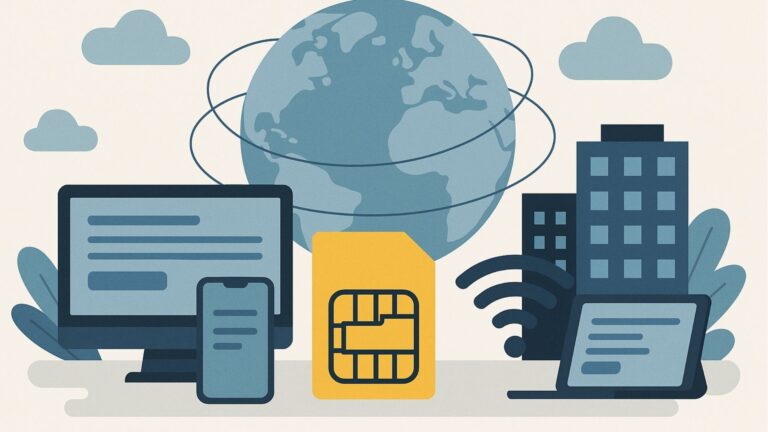From Reactive to Proactive: How CFOs Can Turn Connectivity Into Predictable Spend
Connectivity costs often fluctuate, making budgeting a challenge for CFOs. By adopting a proactive approach, financial leaders can turn these unpredictable expenses into strategic, predictable investments. This guide explores data-driven insights, spend visibility, and scalable solutions for sustainable financial control.

Why Connectivity Is Now a CFO Priority
Connectivity is often viewed as an operational concern — something the IT or travel department handles while finance focuses on budgets and compliance. Yet for modern enterprises, where teams are distributed across continents and employees travel frequently for work, connectivity has become an increasingly unpredictable line item on the financial statement.
Unplanned roaming charges, fragmented contracts with telecom operators, and employee expense reimbursements can balloon into hundreds of thousands of dollars annually for multinational corporations. For CFOs, this creates a recurring challenge: how do you budget for something that is inherently unpredictable?
The answer lies in shifting from reactive cost management to proactive financial control. Instead of firefighting surprise bills, CFOs can use new technologies such as enterprise eSIM platforms to bring predictability, transparency, and scalability to connectivity costs. With proactive strategies, CFOs can treat connectivity like any other strategic expense category — measurable, negotiable, and aligned with overall corporate objectives.
This blog explores how finance leaders can turn connectivity chaos into predictable spend, reduce financial risk, and unlock operational efficiency with solutions like Voye Data Pool.
The CFO’s Connectivity Dilemma
Hidden Costs That Spiral Out of Control
Every CFO knows the pain of hidden costs. Connectivity, especially international roaming and mobile data usage, is a prime example. On the surface, it looks like a manageable expense — after all, employees simply need access to mobile data when they travel. In practice, it’s a financial minefield.
- Roaming charges are unpredictable. Employees may use personal devices, forget to switch off roaming, or consume more data than expected. A single employee’s bill can run into hundreds or thousands of dollars.
- Expense reimbursements lack control. Employees often purchase local SIM cards or data plans and then submit expense claims. Each reimbursement is processed separately, leading to inefficiency and lack of visibility.
- Fragmented telecom contracts add complexity. Large organizations may juggle contracts with multiple carriers across different regions. Each comes with its own pricing model, terms, and renewal dates, creating administrative overhead.
- Lack of real-time visibility. CFOs rarely see connectivity spend until after the money is spent. This reactive model makes forecasting nearly impossible.
A Case Example: The Roaming Shock
Consider a global consulting firm with employees traveling frequently across Europe, Asia, and North America. Despite having some negotiated contracts, consultants often rely on their personal roaming plans. At the end of each quarter, finance receives expense reports with hundreds of line items ranging from $50 to $800 per employee.
In one instance, a single consultant accidentally streamed training videos over mobile data while on a project in Asia. The cost? Over $3,500 in roaming fees. Multiply such incidents across an enterprise, and connectivity becomes a budgetary blind spot.
Why Predictability Matters for CFOs
CFOs thrive on predictability. Forecasting accuracy is the foundation of financial leadership, and connectivity spend — currently volatile — undermines that goal.
- Budgeting accuracy. Predictable costs allow CFOs to allocate resources more effectively across departments.
- Cash flow management. Volatile expenses disrupt working capital planning and liquidity strategies.
- Investor confidence. Public companies must demonstrate cost discipline. Unpredictable spend categories raise red flags.
- Benchmarking efficiency. Predictable models allow for benchmarking across regions and departments, improving performance management.
Other enterprise cost categories, like cloud services or SaaS subscriptions, have already moved to predictable, usage-based, or flat-rate models. Connectivity must follow suit.
From Reactive to Proactive: The CFO Playbook
Shifting from reactive management to proactive strategy requires both mindset change and technology adoption. Below is a step-by-step playbook designed specifically for CFOs.
Step 1: Centralize Connectivity Under a Single Platform
Instead of allowing individual employees or departments to manage their own connectivity, CFOs should centralize it under a corporate-managed solution. An enterprise eSIM platform like Voye Data Pool allows CFOs to assign data access directly to employees without depending on local carriers or manual reimbursements.
Step 2: Enable Bulk Assignment and Instant Activation
Imagine assigning connectivity to 500 traveling employees in one click. With enterprise eSIM, CFOs can do exactly that. This reduces reliance on physical SIM cards, eliminates shipping costs, and ensures employees are never stranded.
Step 3: Gain Real-Time Visibility Into Usage
Reactive models leave CFOs waiting until the bill arrives. Proactive models provide real-time dashboards showing data usage, employee allocation, and spend per country or department. This visibility empowers finance teams to intervene before costs spiral.
Step 4: Set Cost Controls and Spend Ceilings
CFOs can set spending thresholds, data limits, or pool allocations to ensure costs stay within budget. Automated alerts notify both employees and finance teams when usage approaches set limits.
Step 5: Treat Connectivity as a Negotiable Cost
By consolidating spend into a single predictable model, CFOs gain negotiation power. Instead of managing dozens of small contracts or unpredictable bills, enterprises can negotiate enterprise-level pricing with global coverage — a far more efficient model.

Seamless eSIM Connectivity for Enterprises
Activate, manage, and scale eSIMs with ease.
Strategic Impact of Proactive Connectivity
When CFOs move connectivity to a proactive, predictable model, the benefits go beyond cost savings.
Direct Financial Impact
- Elimination of roaming shocks. No more surprise bills.
- Reduced processing costs. Fewer employee reimbursements and fragmented invoices.
- Better budget alignment. CFOs can forecast connectivity spend just like SaaS or cloud subscriptions.
Operational Efficiency
Employees no longer waste time buying SIM cards, filing reimbursements, or troubleshooting connectivity. Finance teams save time reconciling expenses. The result: thousands of hours saved annually across large enterprises.
Risk Mitigation
Unpredictable connectivity creates not only financial but also operational risk. Employees without data access may miss meetings, lose productivity, or struggle in emergencies. Centralized eSIM platforms ensure continuity and compliance.
Stakeholder Alignment
CFOs often struggle to align finance, IT, HR, and travel on connectivity issues. A centralized platform aligns all stakeholders:
- Finance: predictable budgets.
- IT: secure, controlled access.
- HR: easier onboarding of remote employees.
- Travel: smoother employee experience.
Why Voye Data Pool Is the CFO’s Choice
Voye Data Pool is designed specifically for enterprises seeking predictable, scalable connectivity. For CFOs, it delivers:
- Bulk eSIM assignment in 1 minute. Deploy connectivity to hundreds of employees instantly.
- Global coverage in 150+ countries. No need to negotiate with local carriers.
- Centralized dashboard. Track spend, usage, and employee allocation in real-time.
- Predictable pricing models. Choose plans that align with budget cycles and growth plans.
- Seamless integration. Airlines, airports, hotels, and agencies can plug into the platform easily.
- Employee experience. No apps, no physical SIMs, just one-click activation.
With Voye Data Pool, CFOs gain control over one of the last unpredictable expense categories.
Conclusion: From Chaos to Control
Connectivity has long been an unpredictable, reactive expense for enterprises. But CFOs can no longer afford to ignore it. By adopting proactive strategies and leveraging platforms like Voye Data Pool, finance leaders can transform connectivity into a predictable, scalable line item.
The result? Better budgets, happier employees, reduced risk, and stronger investor confidence.
It’s time for CFOs to take control. Turn connectivity from a cost headache into a strategic advantage.



 6 min read
6 min read





